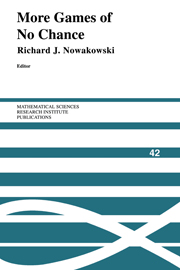Book contents
- Frontmatter
- Contents
- Preface
- The Big Picture
- Idempotents Among Partisan Games
- On the Lattice Structure of Finite Games
- More Infinite Games
- Alpha-Beta Pruning Under Partial Orders
- The Abstract Structure of the Group of Games
- The Old Classics
- Higher Nimbers in Pawn Endgames on Large Chessboards
- Restoring Fairness to Dukego
- Go Thermography: The 4/21/98 Jiang-Rui Endgame
- An Application of Mathematical Game Theory to Go Endgames: Some Width-Two-Entrance Rooms With and Without Kos
- Go Endgames Are PSPACE-Hard
- Global Threats in Combinatorial Games: A Computation Model with Applications to Chess Endgames
- The Game of Hex: The Hierarchical Approach
- Hypercube Tic-Tac-Toe
- Transfinite Chomp
- A Memory Efficient Retrograde Algorithm and Its Application to Chinese Chess Endgames
- The New Classics
- The 4G4G4G4G4 Problems and Solutions
- Experiments in Computer Amazons
- Exhaustive Search in Amazons
- Two-Player Games on Cellular Automata
- Who Wins Domineering on Rectangular Boards?
- Forcing Your Opponent to Stay in Control of a Loony Dot-and-Boxes Endgame
- 1 x n Konane: A Summary of Results
- 1-Dimensional Peg Solitaire, and Duotaire
- Phutball Endgames Are Hard
- One-Dimensional Phutball
- A Symmetric Strategy in Graph Avoidance Games
- A Simple FSM-Based Proof of the Additive Periodicity of the Sprague-Grundy Function of Wythoff's Game
- Puzzles and Life
- The Complexity of Clickomania
- Coin-Moving Puzzles
- Searching for Spaceships
- Surveys
- Unsolved Problems in Combinatorial Game Theory: Updated
- Combinatorial Games: Selected Bibliography With A Succinct Gourmet Introduction
Higher Nimbers in Pawn Endgames on Large Chessboards
Published online by Cambridge University Press: 29 May 2025
- Frontmatter
- Contents
- Preface
- The Big Picture
- Idempotents Among Partisan Games
- On the Lattice Structure of Finite Games
- More Infinite Games
- Alpha-Beta Pruning Under Partial Orders
- The Abstract Structure of the Group of Games
- The Old Classics
- Higher Nimbers in Pawn Endgames on Large Chessboards
- Restoring Fairness to Dukego
- Go Thermography: The 4/21/98 Jiang-Rui Endgame
- An Application of Mathematical Game Theory to Go Endgames: Some Width-Two-Entrance Rooms With and Without Kos
- Go Endgames Are PSPACE-Hard
- Global Threats in Combinatorial Games: A Computation Model with Applications to Chess Endgames
- The Game of Hex: The Hierarchical Approach
- Hypercube Tic-Tac-Toe
- Transfinite Chomp
- A Memory Efficient Retrograde Algorithm and Its Application to Chinese Chess Endgames
- The New Classics
- The 4G4G4G4G4 Problems and Solutions
- Experiments in Computer Amazons
- Exhaustive Search in Amazons
- Two-Player Games on Cellular Automata
- Who Wins Domineering on Rectangular Boards?
- Forcing Your Opponent to Stay in Control of a Loony Dot-and-Boxes Endgame
- 1 x n Konane: A Summary of Results
- 1-Dimensional Peg Solitaire, and Duotaire
- Phutball Endgames Are Hard
- One-Dimensional Phutball
- A Symmetric Strategy in Graph Avoidance Games
- A Simple FSM-Based Proof of the Additive Periodicity of the Sprague-Grundy Function of Wythoff's Game
- Puzzles and Life
- The Complexity of Clickomania
- Coin-Moving Puzzles
- Searching for Spaceships
- Surveys
- Unsolved Problems in Combinatorial Game Theory: Updated
- Combinatorial Games: Selected Bibliography With A Succinct Gourmet Introduction
Summary
ABSTRACT. We answer a question posed in [Elkies 1996] by constructing a class of pawn endgames onmXn boards that show the Nimbers *k for many large k. We do this by modifying and generalizing T.R. Dawson's “pawns game” [Berlekamp et al. 1982]. Our construction works for and n sufficiently large; on the basis of computational evidence we conjecture, but cannot yet prove, that the construction yields *k for all integers k.
1. Introduction
In [Elkies 1996] we showed that certain chess endgames can be analyzed by the techniques of combinatorial game theory (CGT). We exhibited such endgames whose components show a variety of CGT values, including integers, fractions, and some infinite and infinitesimal values. Conspicuously absent were the values *k of Nim-heaps of size k > 1. Towards the end of [Elkies 1996] we asked whether any chess endgames, whether on the standard 8 x 8 chessboard or on larger rectangular boards, have components equivalent to *2, *4 and higher Nimbers. In the present paper we answer this question affirmatively by constructing a new class of pawn endgames on large boards that include *k for many large k, and conjecture — though we cannot yet prove — that all *k arise in this class.
Our construction begins with a variation of a pawns game called “Dawson's Chess” in [Berlekamp et al. 1982]. In §3 we introduce this variation and show that, perhaps surprisingly, all quiescent (non-entailing) components of the modified game are equivalent to Nim-heaps (Theorem 1). We then determine the value of each such component, and characterize non-loony moves (Theorem 2). In § 4 we construct pawn endgames on large chessboards that incorporate those components. These endgames do not yet attain our aim, because the values determined in Theorem 2 are all 0 or *1. In §5 we modify one of our components to obtain *2. In §6 we further study components modified in this way, showing that they, too, are equivalent to Nim-heaps (Theorem 3). We conclude with the numerical evidence suggesting that all Nim-heaps can be simulated by components of pawn endgames on large rectangular chessboards.
Information
- Type
- Chapter
- Information
- More Games of No Chance , pp. 61 - 78Publisher: Cambridge University PressPrint publication year: 2002
